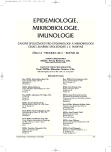Cases of Menstrual Toxic Shock Syndrome in the Czech Republic in 1997–2011
Authors:
P. Petráš 1; I. Machová 1; Lenka Ryšková 2
; P. Prášil 3
Authors place of work:
NRL pro stafylokoky, SZÚ Centrum epidemiologie a mikrobiologie, Praha
1; Ústav klinické mikrobiologie, FN Hradec Králové
2; Klinika infekčních nemocí, FN Hradec Králové
3
Published in the journal:
Epidemiol. Mikrobiol. Imunol. 60, 2011, č. 4, s. 161-166
Summary
Aim:
To determine toxigenicity and other basic characteristics of 47 strains of Staphylococcus aureus referred to the National Reference Laboratory for Staphylococci (NRL) as suspected causative agents of menstrual toxic shock syndrome (MTSS).
Material and methods:
S. aureus strains were collected from 11 administrative regions of the Czech Republic in 1997–2011. The diagnosis was based on phenotypic (reverse latex agglutination test) and genotypic (polymerase chain reaction) methods.
Results:
Forty-four S. aureus strains were producers of toxic shock syndrome toxin 1 (TSST-1), either alone or in combination with staphylococcal enterotoxin. Three strains only produced enterotoxin (B, C, and H).
Conclusion:
MTSS is a serious multisystem disease. In this study, MTSS often had a severe course requiring intensive care. All MTSS patients used vaginal tampons that had been identified in the literature as a risk factor for MTSS. The case of MTSS in a 36-year-old woman caused by an enterotoxin H positive strain of S. aureus is probably the first to be reported in the world.
Keywords:
toxic shock syndrome (TSS) – menstrual TSS – Staphylococcus aureus
Zdroje
1. McCormic, J. K., Yarwood, J. M., Schlievert, P. M. Toxic shock syndrome and bacterial superantigens: an update. Annu. Rev. Microbiol., 2001, 55, p. 77–104.
2. Centers for disease control and prevention Case definition for public health surveillance. Morb. Mortal. Wkly. Rep. (MMWR), 1990, 39, p. 38–39.
3. MedicalCRITERIA.com 2001. Case definition of staphylococcal toxic shock syndrome (TSS). Dostupné na www: http://www.medicalcriteria.com/criteria/inf_tss.htm
4. Todd, J., Fishaut, M., Kapral, F., Welch, T. Toxic-shock syndrome associated with phage-group-I staphylococci. Lancet, 1978, 2, p. 1116–1118.
5. Shands, K. N., Schmid, G. P., Dan, B. B. et al. Toxic-shock syndrome in menstruating women: association with tampon use and Staphylococcal aureus and clinical features. N. Engl. J. Med., 1980, 303, p. 1429.
6. Mašata, J., Jedličková, A. et al. Infekce v gynekologii a porodnictví. Maxdorf 2004. ISBN 80-7345-038-0.
7. Andrysík, T., Machová, I., Petráš, P., Votava, M. Průkaz hyaluronidázy u kmenů rodu Staphylococcus. Zprávy CEM (SZÚ, Praha), 2004, 13, 5, p. 210–212.
8. Petráš, P., Prusík, F., Nyč, O., Machová, I. Nemocniční kmeny MRSA s negativním clumping-faktorem. Zprávy CEM (SZÚ, Praha), 2005, 14, 3, p. 122–124.
9. Martineau, F., Picard, F., Roy, P. Species-specific and ubiquitous-DNA-based assay for rapid identification of Staphylococcus aureus. J. Clin. Microbiol., 1998, 36, p. 618–623.
10. Petráš, P. Detection of staphylococcal enterotoxigenicity. J. Hyg. Epidemiol. Microbiol., 1980, 24, p. 22–28.
11. Lovseth, A., Loncarevic, S., Bergal, K. Modified multiplex PCR method for detection of pyrogenic exotoxin genes in staphylococcal isolates. J. Clin. Microbiol., 2004, 42, p. 3689–3872.
12. Fischer A., Francois, P., Holtfreter, S. Development and evaluation of a rapid strategy to determine enterotoxin gene content in Staphylococcus aureus. J. Microbiol. Meth., 2009, 77, p. 184–190.
13. Urbášková, P., Macková, B., Melter O. Disk s cefoxitinem – spolehlivá metoda pro vyhledávání kmenů stafylokoků rezistetních k oxacilinu. Zprávy CEM (SZÚ, Praha), 2004, 13, 7, p. 296–297.
14. Manual of Routine Phage Typing of Staphylococcus aureus 1989. Staphylococcus Reference Unit, Central Public Health Laboratory, London – Colindale, UK.
15. Infekce v České republice – EPIDAT. Dostupné na www: http://www.szu.cz/publikace/data/infekce-v-cr
16. Tang, Y. W., Himmelfarb, E., Wills, M., Stratton, C. W. Characterization of three Staphylococcus aureus isolates from a 17-year-old female who died of tampon-related toxic shock syndrome. J. Clin. Microbiol., 2010, 48, 5, p. 1974–1977.
17. Su, Y. C., Lee Wong, A. C. Identification and purification of a new staphylococcal enterotoxin. H. Appl. Environ. Microbiol., 1995, 61, 4, p. 1438–1443.
18. Chen, T. R., Chiou, C. S., Tsen, H. Y. Use of novel PCR primers specific to the genes of staphylococcal enterotoxin G, H, I for the survey of Staphylococcus aureus strains isolated from food-poisoning cases and food samples in Taiwan. Int. J. Food Microbiol., 2004, 92, p. 189–197.
19. Ikeda, T., Tamate, N., Yamaguchi, K., Makino, S. Mass outbreak of food poisoning disease caused by small amounts of staphylococcal enterotoxins A and H. Appl. Environ. Microbiol., 2005, 71, p. 2793–2795.
20. Loncarevic, S., Mathisen, T. Characterisation of Staphylococcus aureus enterotoxin type H from food outbreak. In 5th World Congress Foodborne Infections and Intoxications. Berlin 2004, p. 118.
21. Pospíšilová, M., Karpíšková, R. Případ stafylokokové enterotoxikózy vyvolané netradičním toxinem SEH. Zprávy CEM (SZÚ, Praha), 2005, 14, 2, p. 84–85.
22. Minksová, B. Vložka nebo tampon? (Rozhovor s MUDr. R. Uzlem) 2008. Dostupné na www: http://www.lidovky.cz/ tiskni.asp?r=ln_noviny&c=A080219_000133_ln_noviny_sko
23. Petráš, P., Ryšková L., Machová I., Prášil P. Menstruální syndrom toxického šoku vyvolaný kmenem Staphylococcus aureus s produkcí enterotoxinu H. Zprávy CEM (SZÚ, Praha), 2011, 20, 4, p. 145–147.
Štítky
Hygiena a epidemiológia Infekčné lekárstvo MikrobiológiaČlánok vyšiel v časopise
Epidemiologie, mikrobiologie, imunologie

2011 Číslo 4
- Parazitičtí červi v terapii Crohnovy choroby a dalších zánětlivých autoimunitních onemocnění
- Očkování proti virové hemoragické horečce Ebola experimentální vakcínou rVSVDG-ZEBOV-GP
- Koronavirus hýbe světem: Víte jak se chránit a jak postupovat v případě podezření?
Najčítanejšie v tomto čísle
- Případy menstruální formy syndromu toxického šoku v České republice v letech 1997–2011
- Izolace Cronobacter spp. (dříve Enterobacter sakazakii) z nozder zdravého ustájeného koně – krátké sdělení
- Šedesát let výzkumu klíšťové encefalitidy – cesty k analýze současné epidemiologické situace ve střední Evropě
- Vybrané kapitoly verejného zdravotníctva I.
